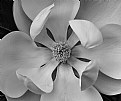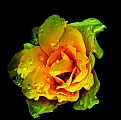
Patrick Ziegler
(K=21797) - Comment Date 3/18/2007
|
You need to learn the basics of flash exposure. There is a ton of information out there. ( http://markhancock.blogspot.com/2005/11/understand-basic-flash-exposure.html ) and much much more.
|
|
|
|

Dana Howcroft
(K=0) - Comment Date 4/9/2007
|
f(aperture opening)
sp(shutter speed)
f/22=sp4
f/16=sp8
f/11=sp15
f/8=sp30
f/5.6=sp60
f/4=sp125
f/2.8=250
f/2.0=sp500
Aperture
These are the set of numbers on your lens closest to the body of the camera. They can go from 1.8 to 22, and they are referred to as F-stops. These numbers determine how much light reaches the film inside of your camera. Most internal meters will blink on the appropriate aperture for the shutter speed that you’ve set, or the speed you’ve set will blink if your F-stop is correct for the speed. Both the F-stop and shutter speed can be changed to expose the scene correctly. Consider that the faster the shutter speed the more light will be needed to expose the scene correctly. This makes logical sense if you think about it. If the shutter isn’t open as long, fast shutter speed, then there is less light able to make it to the film and so the scene must be brighter to expose correctly. To learn, bracket your shots. Take the first shot at the aperture suggested by your meter, move one stop up, take a photo, one down, take another photo.
F-stop the common term for the aperture setting (f-number) of a lens; the f-number is equal to the focal length of a lens divided by the diameter of the aperture. You set your shutter speed to 250 for everyday photograpy. I hope that helps I got this from an internet search. I'm new too and enjoy black and white photograpy. My name is Dana if you want to chat about photography. Also look up on the internet for your camera model and you should be able to find an old manual.
|
|
|
|

Dana Howcroft
(K=0) - Comment Date 4/9/2007
|
f(aperture opening)
sp(shutter speed)
f/22=sp4
f/16=sp8
f/11=sp15
f/8=sp30
f/5.6=sp60
f/4=sp125
f/2.8=250
f/2.0=sp500
Aperture
These are the set of numbers on your lens closest to the body of the camera. They can go from 1.8 to 22, and they are referred to as F-stops. These numbers determine how much light reaches the film inside of your camera. Most internal meters will blink on the appropriate aperture for the shutter speed that you’ve set, or the speed you’ve set will blink if your F-stop is correct for the speed. Both the F-stop and shutter speed can be changed to expose the scene correctly. Consider that the faster the shutter speed the more light will be needed to expose the scene correctly. This makes logical sense if you think about it. If the shutter isn’t open as long, fast shutter speed, then there is less light able to make it to the film and so the scene must be brighter to expose correctly. To learn, bracket your shots. Take the first shot at the aperture suggested by your meter, move one stop up, take a photo, one down, take another photo.
F-stop the common term for the aperture setting (f-number) of a lens; the f-number is equal to the focal length of a lens divided by the diameter of the aperture. You set your shutter speed to 250 for everyday photograpy. I hope that helps I got this from an internet search. I'm new too and enjoy black and white photograpy. My name is Dana if you want to chat about photography. Also look up on the internet for your camera model and you should be able to find an old manual.
|
|
|
|

Patrick Ziegler
(K=21797) - Comment Date 4/10/2007
|
The question, I belive, was about flash photography.
|
|
|
|

Jeroen Wenting
 (K=25317) - Comment Date 4/10/2007
(K=25317) - Comment Date 4/10/2007
|
Without understanding about aperture you're not going to understand the aperture table printed on a flash unit :)
|
|
|
|

Patrick Ziegler
(K=21797) - Comment Date 4/10/2007
|
No argument from me on that one Jeroen, But you also need to know about things like guide number, max sync etc., How guide number, aperture and distance relate to each other and so on.
I just thought an explanation of shutter/aperture was inappropriate answer to a question about how to use the f/stop numbers on a flash head.
Comments like, “the faster the shutter speed the more light will be needed to expose the scene correctly” might confuse a newbie trying to understand flash exposure.
One needs to draw the distinction between flash/aperture and shutter/aperture and then perhaps explain how you can make both exposures in one shot.
I don’t think there is enough room in a forum post to do a good job, hence my link posted above.
|
|
|
|

Terry Geldard
(K=-165) - Comment Date 6/5/2007
|
Buy a cheap flash meter or just get a hold of a dedicated flash unit either one makes it easier (or "cheating" some call it) to get your exposure right for the flash.
if your using digital (mosst are these day's) then just fire some test shots off and adjust either the flashes power output or aperture accordingly.
holla if you need any more help.
|
|
|
|

Roger Skinner
 (K=81846) - Comment Date 8/10/2007
(K=81846) - Comment Date 8/10/2007
|
buy a dedicated speed light.. it'll calculate everything for you
|
|
|
|

chanel garcia
(K=31) - Comment Date 8/13/2007
|
Thank you all for replying it has really helped. I hope to grow a lot as new photographer. 
|
|
|
|
















